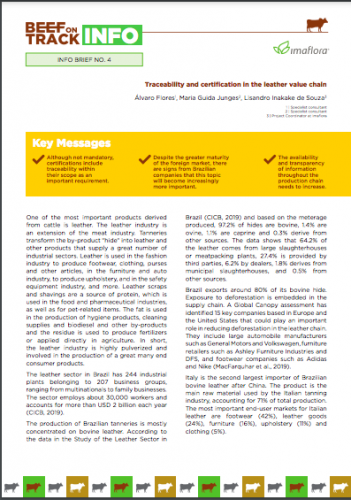The leather industry shows potential to increase traceability

The beef issue is widely discussed and represents only 60% of the cattle's weight. One of the most important products derived from cattle is leather. A total of 39.5 million cattle hides supply a very pulverized value chain and, for this very reason, has the potential to strengthen the demand for the traceability of bovine production.
The Beef on Track program published a study entitled Traceability and certification in the leather value chain precisely to shed light on this matter. Developed by Imaflora’s project coordinator Lisandro Inakake de Souza, and by expert consultants Álvaro Flores and Maria Guida Junges, Info Brief 4 addresses the importance of certifications, the signaling of local company engagement in the traceability issue, and the need for more transparency throughout the production chain.
According to the Centre for the Brazilian Tanning Industry (CICB), leather is used in the industries of footwear and fashion in general, furniture and auto making, food and pharmaceuticals and others, but most of the production, around 80%, is for export. The leather sector in Brazil has 244 industrial plants belonging to 207 business groups, ranging from multinationals to family businesses. The sector employs about 30,000 workers and accounts for more than USD 2 billion each year, according to CICB.
Customers in this chain are requesting more information about the origin of the raw materials, mainly buyers linked to the fashion market, pressured by consumers and the market itself, especially in the footwear sector. A Global Canopy assessment has identified 15 key companies based in Europe and the United States that could play an important role in reducing deforestation in the leather chain. They include large automobile manufacturers such as General Motors and Volkswagen, furniture retailers such as Ashley Furniture Industries and DFS, and footwear companies such as Adidas and Nike. Italy is the second largest importer of Brazilian bovine leather after China.
Minerva Foods and Imaflora announce partnership in program to measure carbon balance of South American farms
Carbon On Track will collect primary data regarding carbon balance and present the information on a digital platform.
INFO BRIEF Nº. 2 - MONITORING CATTLE SUPPLIERS: THE NECESSARY HARMONIZATION
The document shows the importance of clear and precise rules to guide the monitoring of cattle suppliers in the Amazon.
COMPARATIVE ANALYSIS IN THE BEEF VALUE CHAIN: SETTING THE BAR TO CREATE THE VOLUNTARY PROTOCOL FOR MONITORING CATTLE SUPPLIERS IN THE CERRADO REGION – Draft 1 for consultation – July, 2021
This study shows that most of the companies and non-governmental initiatives in this analysis have agreed not to convert the biome, however, there is a lack of alignment in the criteria and parameters used.




